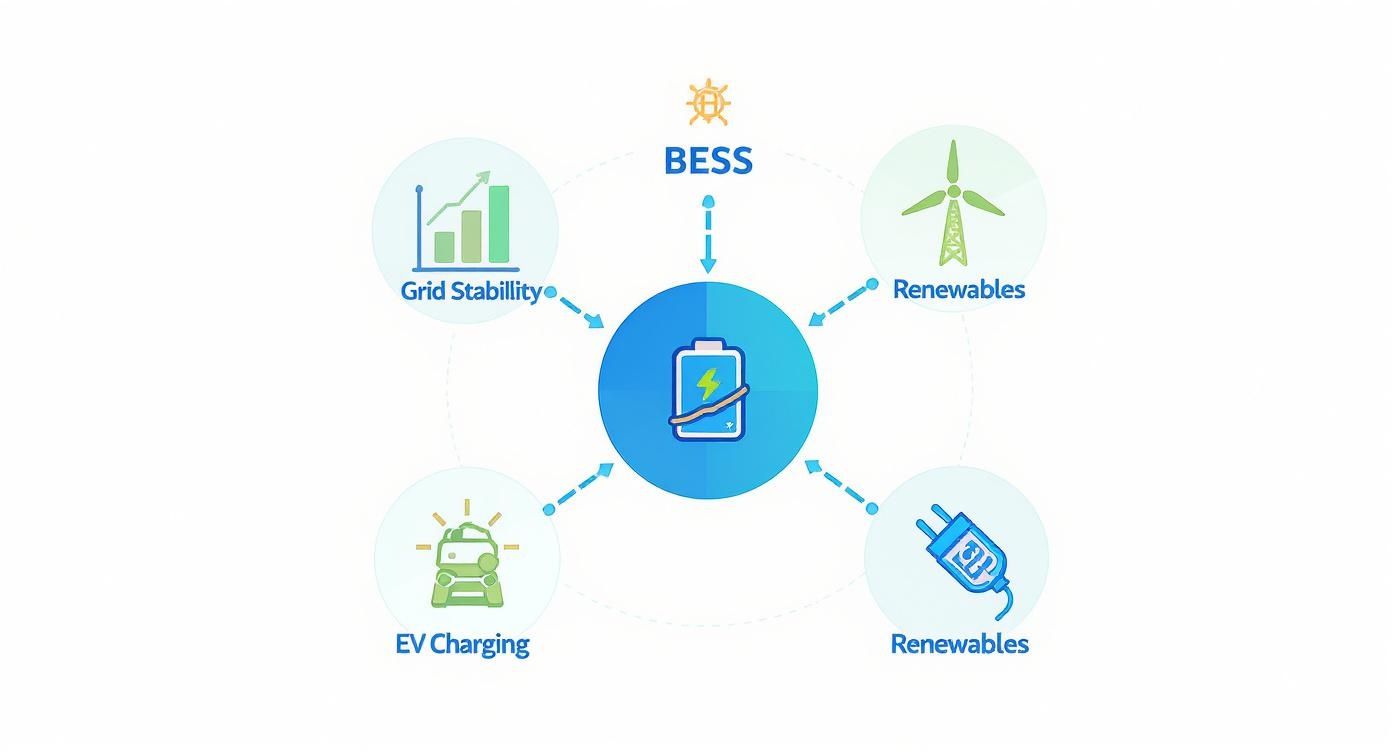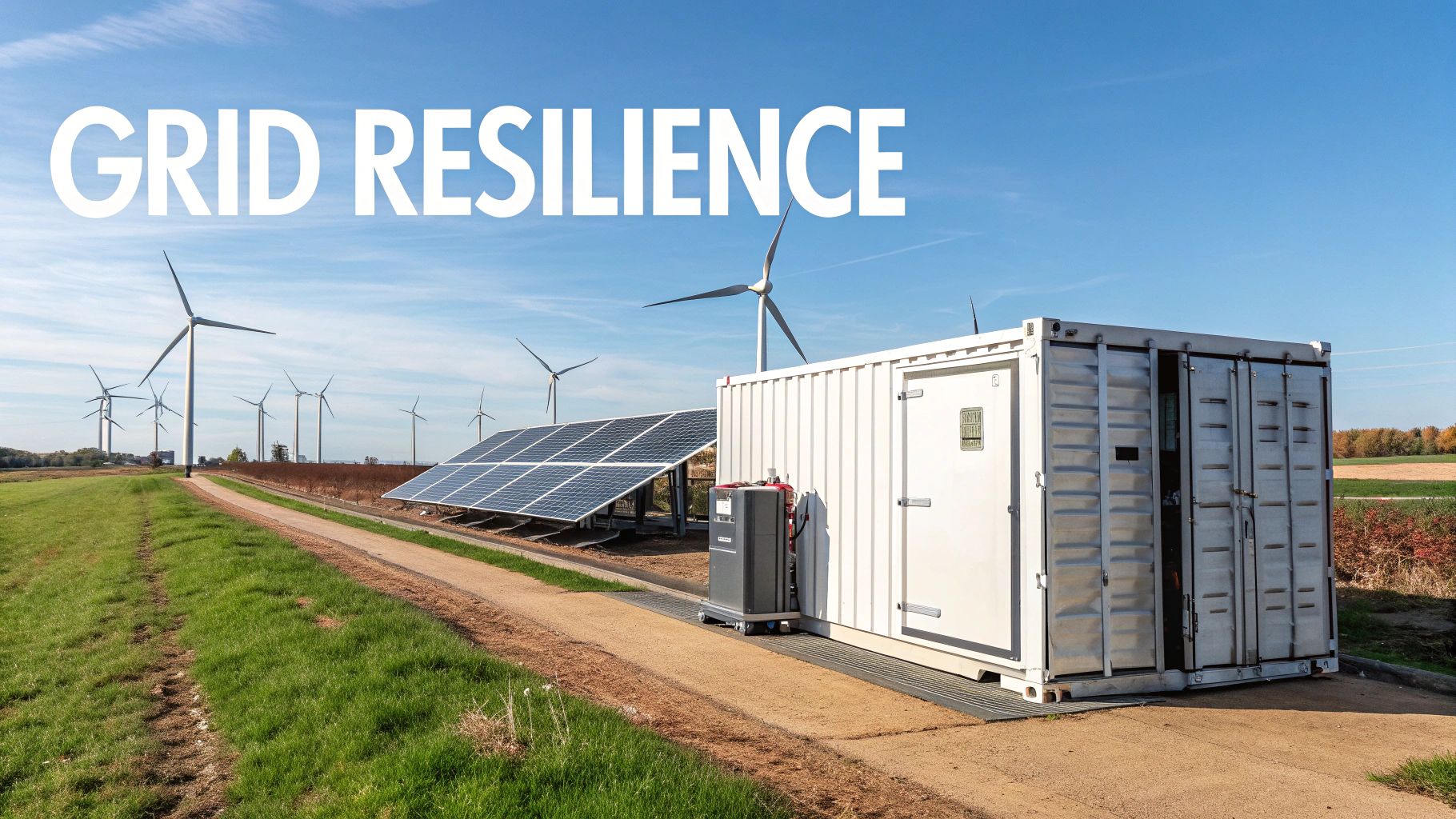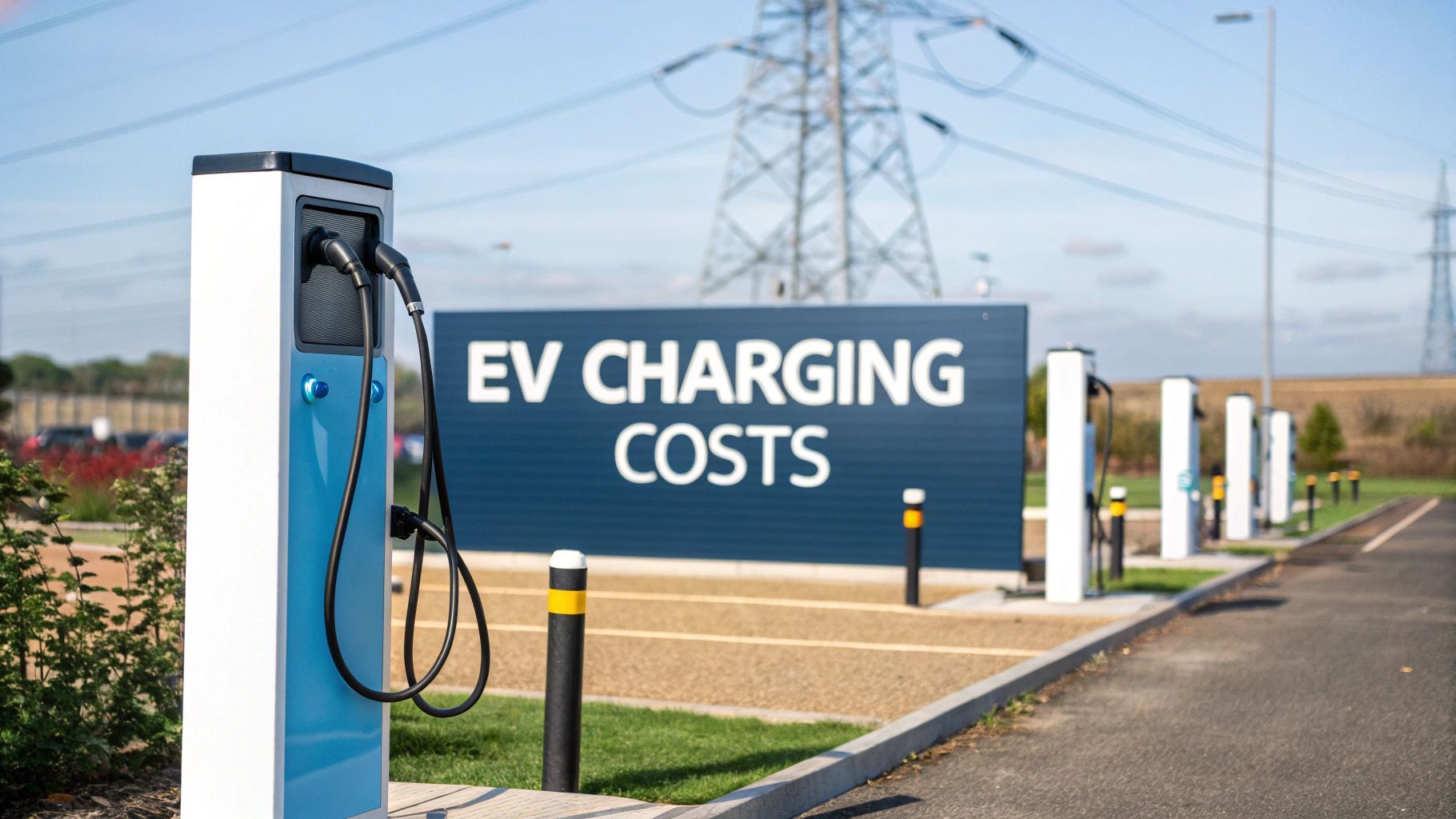battery energy storage systems bess: UK grid & EV charging
Think of a Battery Energy Storage System (BESS) as a financial savings account but for electricity. It’s a simple concept: you capture energy when it’s plentiful and cheap—like on a windy or sunny day—and save it for when you need it most. This simple act is creating a much more resilient and flexible UK energy grid.
The Foundation of Modern Energy Grids
A BESS is not just a big battery; it is a critical piece of infrastructure that makes our transition to renewable energy possible.
Imagine trying to power a city using only solar panels. When the sun is high in the sky, you have abundant energy, maybe even more than you need. But what happens when clouds roll in or night falls? The power supply stops. This on-again, off-again nature—its intermittency—is the central challenge for renewables.
This is where battery energy storage systems step in, acting as a giant reservoir. They absorb all that surplus electricity when generation outstrips demand. Then, they release it back to the grid when demand peaks or when the sun is not shining. This function is vital for grid-scale batteries, guaranteeing a constant, reliable flow of power to homes and businesses.
Why BESS is Essential for the UK
The UK’s commitment to clean energy has sparked a massive increase in battery storage capacity. This is not just a trend; it is a strategic necessity. A robust network of these systems helps in several key ways:
- Stabilise the Grid: A BESS can respond in milliseconds, injecting power to balance supply and demand. This rapid response is crucial for preventing potential blackouts.
- Support Renewable Integration: It smooths out the fluctuating output from wind and solar farms, turning them into dependable, consistent contributors to our national energy mix.
- Enable EV Charging: These systems are fundamental for deploying rapid EV charging, especially in areas with constrained grid connections.
- Create Distributed Energy Networks: By combining on-site renewables, EV charging and batteries, businesses can slash their reliance on the grid and get a real grip on their energy costs.
The growth in this sector has been remarkable. Since 2020, operational battery storage capacity in the UK has increased by an astonishing 509% , climbing from 1,128 MW to 6,872 MW. This surge highlights the strategic importance of BESS in stabilising the nation's energy system. Discover more insights about the UK battery market on RenewableUK.com.
Beyond large-scale grid applications, battery storage is also becoming essential for residential use, providing reliability and resilience through various home battery backup systems. In short, BESS is the key that unlocks a cleaner, more efficient and secure energy future for everyone.
How Battery Storage Technology Actually Works
To really get your head around the value of a battery energy storage system (BESS) , you need to look past the big container and see what is going on inside. A BESS is not a single piece of kit; it is a sophisticated system made up of four distinct parts, all working together in perfect harmony.
Think of it as a complete ecosystem designed for one purpose: to create a seamless flow of energy, from the moment it is captured to the second it is deployed. Let’s break down exactly how it all fits together, starting with the most obvious component—the batteries.
The Heart of the System: The Battery Array
At the core of every BESS, you will find the Battery System . This is the physical powerhouse where electrical energy is stored chemically. While there are a few different chemistries out there, the vast majority of modern systems—from grid-scale giants to the compact units that support rapid EV charging—rely on lithium-ion technology .
You can think of the battery system as a massive reservoir. It is not just one big battery but thousands of individual battery cells, all neatly grouped into modules. These modules are then stacked into larger racks, creating a powerful, high-capacity array capable of storing huge amounts of energy.
This modular design is what makes a BESS so adaptable. Whether it is a small unit for a mobile EV charger or a sprawling installation designed to stabilise the national grid, the basic principle is the same. But just holding onto energy is only half the job; it has to be managed with incredible precision.
The Brains of the Operation: The Battery Management System
Enter the Battery Management System (BMS) . If the batteries are the heart of the system, the BMS is the brain, keeping a constant watch over the health and status of every single cell. Its main job is to ensure the whole array operates safely, efficiently and for as long as possible.
The BMS diligently tracks several critical parameters to keep everything in balance:
- Voltage: It stops the cells from overcharging or draining too far, both of which can cause permanent damage.
- Current: It makes sure the flow of electricity stays within safe limits during both charging and discharging.
- Temperature: It constantly monitors cell temperatures to prevent overheating—a crucial safety feature to avoid thermal runaway.
By balancing the charge across all the cells, the BMS squeezes the maximum usable capacity out of the battery and extends its working life. It is like a silent guardian, making thousands of tiny adjustments every second to keep the entire system humming along perfectly.
This infographic shows just how central battery energy storage systems have become in connecting renewables, the grid and EV charging.

A BESS is more than just batteries; it is a collection of specialised components working in concert. The table below breaks down the key players and what they do.
Core Components of a Battery Energy Storage System
| Component | Primary Function | Analogy |
|---|---|---|
| Battery System | Stores electrical energy chemically using thousands of interconnected battery cells. | The Reservoir —holding the energy until it's needed. |
| Battery Management System (BMS) | Monitors and protects individual battery cells to ensure safety and longevity. | The Brain —managing the physical health of the battery array. |
| Power Conversion System (PCS) | Converts electricity between Direct Current (DC) for storage and Alternating Current (AC) for use. | The Translator —bridging the gap between the battery and the grid. |
| Energy Management System (EMS) | Makes high-level decisions on when to charge or discharge based on external data. | The Commander —directing the entire system to meet strategic goals. |
Each part is essential for the system to function effectively, from the cellular level right up to grid-scale energy trading.
The Universal Translator: The Power Conversion System
Here’s a simple fact: batteries store energy as Direct Current (DC) but our national grid, homes and businesses all run on Alternating Current (AC). The Power Conversion System (PCS) is the essential bit of tech that bridges this gap. It is a clever bidirectional inverter that handles two critical jobs.
When the BESS is charging, the PCS converts AC power from the grid or renewables into DC power to be stored in the batteries. When it is discharging, it does the exact opposite, turning the battery’s DC power back into high-quality AC power that can be sent to the grid or used to power EV chargers.
The PCS is not just a simple converter; it is the gateway to the grid. Its ability to manage the flow and quality of electricity with precision is fundamental for applications like frequency response, where split-second accuracy is needed to keep the grid stable.
The Strategic Commander: The Energy Management System
Finally, we have the Energy Management System (EMS) , which acts as the strategic commander making all the big decisions. While the BMS is focused on the battery's physical health, the EMS is looking at the bigger picture—telling the whole system what to do and when to do it.
The EMS uses advanced software to control the BESS, analysing data like grid electricity prices, local energy demand and even weather forecasts for renewable generation. Based on this information, it decides the best moments to charge from the grid, discharge to support EV charging or store solar energy to cut costs.
For grid-scale batteries, the EMS is the engine that executes complex energy trading strategies, making sure the asset delivers the best possible financial return. It is what turns a big box of batteries into a smart, responsive and profitable asset.
Real World BESS Applications Across the UK

It is easy to talk about the theory but battery energy storage systems (BESS) are already making a tangible impact on the UK’s energy landscape. From huge grid-scale batteries acting as shock absorbers for the National Grid to smaller, localised units empowering businesses and communities, BESS technology is being put to work in some seriously powerful ways.
These systems are not some far-off concept; they are operating right now, building a more stable, efficient and decarbonised grid. Let’s look at how they are being used across the country.
Supporting the Grid with Grid-Scale Batteries
The most visible application is the grid-scale battery . We are talking about massive installations, often spread across dozens of containers, strategically placed to keep the National Grid balanced. Their main job is to provide essential grid services, with frequency response being the most critical.
Think of the grid’s frequency as its heartbeat, which needs to stay at a steady 50 Hz . If a large power station suddenly trips offline, that heartbeat can falter, risking widespread blackouts. Grid-scale batteries react in milliseconds, pumping huge amounts of power into the system to stabilise the frequency and keep the lights on.
They are also masters of energy arbitrage. This simply means charging up with cheap electricity during off-peak hours—like the middle of the night when wind farms are spinning but demand is low—and selling it back to the grid when prices peak. It is a simple concept that helps balance supply and demand, making the whole system more efficient and affordable.
Combining On-Site Renewables and Battery Storage
For businesses, pairing a BESS with on-site renewables like solar panels is a complete game-changer. A commercial building with a roof full of solar panels might generate a massive amount of free electricity on a sunny afternoon. But if the business is not using it all, that surplus energy is often exported back to the grid for a pittance.
This is where a BESS comes in. Instead of giving that energy away, the battery captures and stores it. Later, when the sun goes down and the evening energy tariffs kick in, the business can run on its own stored solar power, drastically cutting its reliance on expensive grid electricity. This combined approach of on-site renewables, EV charging and batteries allows businesses to take control of their energy strategy.
This strategy, known as peak shaving, allows businesses to slash their energy bills and achieve a much greater degree of energy independence. It transforms a simple solar installation into a comprehensive energy solution, maximising the return on investment.
It is not just about cost savings, either. This approach provides a crucial backup during power cuts and helps companies achieve a genuinely greener operational footprint.
Enabling EV Charging from Constrained Grid Connections
One of the biggest roadblocks to rolling out rapid EV charging is the local grid connection. So many ideal locations for charging hubs—think petrol station forecourts or retail parks—have grid connections that were never designed to handle the colossal power draws needed for multiple rapid chargers. Upgrading them can cost a fortune and take years.
BESS offers an elegant way around this problem. A battery system can be installed on-site and ‘trickle charge’ itself from the weak grid connection over many hours. When several EVs pull up to charge at once, the BESS unleashes its stored energy in a powerful burst, delivering the high power needed for rapid EV charging without ever overloading the local grid.
- Bypasses Grid Limitations: It unlocks rapid charging infrastructure where it would otherwise be impossible to install.
- Enables Mobile EV Charging: Smaller BESS units are the heart of mobile EV charging services, bringing power directly to a stranded vehicle.
- Improves Charger Uptime: By acting as a buffer, a BESS ensures chargers get a consistent power supply, even when the grid voltage fluctuates.
For a deeper look into practical applications, you can read our case studies that prove ZPN delivers where others don't .
Powering the Future with Distributed Energy
The whole idea of distributed energy is to shift away from a handful of massive, centralised power stations towards a smarter network of smaller, local energy assets. BESS is the cornerstone of this vision.
Imagine a network of smaller BESS units dotted around at businesses, EV charging hubs and community solar farms, all working together. They can store locally generated renewable energy and share it within the community, reducing the strain on the national transmission lines.
This creates stronger, more self-sufficient local grids that are far less vulnerable to large-scale outages. It is a fundamental shift in how we generate, store and use power, with BESS right at its centre. The financial case is getting stronger, too. For instance, recent market conditions saw BESS revenues in the UK jump by 20% in a single month—that's equivalent to £76,000/MW/year . This was driven by their ability to capitalise on price volatility during heatwaves and windy periods. You can discover more insights about BESS financial performance from Modo Energy.
Unlocking Rapid EV Charging with BESS

One of the most powerful applications for battery energy storage systems (BESS) is solving the electric vehicle charging puzzle. As more drivers go electric, the demand for fast, convenient charging is soaring. The problem? Our existing grid infrastructure often just cannot keep up. This is where a BESS completely changes the game.
Think about a busy motorway service station. Installing a row of rapid chargers, each delivering 150kW or more to multiple cars, would put a colossal strain on the local grid. In many places, the connection simply is not powerful enough. A traditional grid upgrade is a massive undertaking—incredibly expensive, disruptive and can take years to complete.
But a BESS offers a far more elegant solution. It acts as an energy reservoir, effectively decoupling the chargers from the immediate limits of the grid.
Overcoming Constrained Grid Connections
The biggest headache with rapid EV charging from constrained grid connections is the sheer, sudden demand for power. A BESS gets around this by cleverly managing the energy flow over time. It can slowly 'trickle charge' itself from a weak grid connection during off-peak hours when electricity demand and costs are low.
It is like filling a huge water tank with a small hose. It might take a while but once full, you can open a massive valve and release a powerful gush of water instantly. A BESS does the exact same thing with electricity, accumulating power steadily and then unleashing it in high-speed bursts to charge several EVs at once.
This 'peak shaving' capability is fundamental. It allows developers to deploy extensive rapid charging hubs in prime locations without needing a costly and time-consuming grid upgrade, making widespread charging a commercial reality today, not a future ambition.
This approach not only makes these installations possible but also helps manage costs by drawing power when it is cheapest. It is a smarter, more efficient path to building the infrastructure we need. For businesses exploring this, understanding the benefits of battery-backed EV charging is the first step to future-proofing their operations.
Enabling True Charging Flexibility
The partnership between EV charging and batteries goes well beyond fixed locations. This technology is also powering a new generation of flexible charging solutions, tackling everything from roadside recovery to providing temporary power at events.
A key development here is mobile EV charging . These are essentially BESS units on wheels, designed to bring the charger directly to a stranded vehicle. A van fitted with a compact but potent battery system can drive out to a driver who has run flat and deliver enough power to get them to the nearest static charge point.
This service helps to eliminate one of the biggest anxieties for potential EV buyers—the fear of getting stranded. It is becoming a vital tool for fleet operators and recovery companies, all powered by a portable BESS.
Building Resilient Charging Hubs
Integrating a BESS into a charging hub does more than just solve grid capacity issues; it creates a much more resilient and reliable service. If a local power cut hits, a charging site without battery backup is completely out of action.
However, a site with a battery energy storage system can carry on. It can ‘island’ itself from the grid and use its stored energy to keep the chargers running, providing a critical service when other infrastructure is down. This is crucial for sites serving commercial fleets or emergency services, where charger uptime is simply non-negotiable.
This ability is central to the idea of distributed energy , where local sites can generate, store and use their own power. Imagine combining a BESS with on-site renewables like solar panels on a car park canopy—you create a truly self-sufficient charging ecosystem.
This integrated system offers several powerful benefits:
- Energy Independence: The site generates and stores its own clean electricity, reducing reliance on the grid and exposure to volatile energy prices.
- Enhanced Resilience: It can function seamlessly during grid outages, ensuring continuous operation for drivers.
- New Revenue Streams: Stored energy can be sold back to the grid during peak times, turning the charging hub into a valuable energy asset.
Ultimately, BESS is the technology that makes rapid, reliable and resilient EV charging a practical reality across the UK, accelerating our journey to electric mobility.
The Future of the UK BESS Market
The UK’s market for battery energy storage systems (BESS) is growing at a phenomenal pace. This is not just a happy accident; it is the result of several powerful forces all hitting at once: supportive government policies, battery costs that just keep dropping and the undeniable need to make our grid more flexible as we plug in more and more renewables.
This combination of factors has created the perfect environment for investment and development, firmly placing the UK as a leader in battery storage. The sheer volume of projects in the pipeline tells the story. In fact, recent data shows just how busy things have become, with a 78% jump in completed projects in the first half of one year compared to the last. You can read more about the UK's soaring battery storage activity on Energy-Storage.news.
The Driving Forces Behind Market Expansion
The main engine here is the UK's commitment to decarbonisation. As we bring more wind and solar online, the grid needs a way to balance out their natural fluctuations. Grid-scale batteries are the best tool for the job, providing the super-fast response needed to keep everything stable. This need alone has fuelled massive investment into large-scale BESS projects.
Cost is the other major piece of the puzzle. The price of lithium-ion batteries has fallen off a cliff over the last decade. This has completely changed the economics, making large storage projects not just possible but genuinely attractive to investors. BESS is no longer a niche bit of kit—it is now a mainstream, profitable asset class that is essential for building a modern energy system.
Emerging Trends Shaping the Future
Looking ahead, the UK BESS market is set to evolve even further. A few key trends are already starting to define what comes next for energy storage.
One of the most important shifts is the move towards longer-duration storage . Most systems today are built for short, sharp bursts of power to manage grid frequency. But there is a growing demand for batteries that can discharge for four hours or more. These will be vital for handling bigger, longer-term gaps between when renewable energy is generated (like solar at midday) and when it is needed (like the evening peak).
Artificial intelligence (AI) and machine learning are also stepping into the spotlight. AI-powered software is becoming crucial for getting the most out of a BESS. It can predict market prices and grid needs with incredible accuracy, allowing for smarter energy trading that makes the whole operation more effective and profitable.
Integrating V2G with Stationary BESS
Perhaps the most exciting long-term trend is blending vehicle-to-grid (V2G) technology with stationary battery storage. V2G is a game-changer because it allows electric vehicles to not only charge from the grid but also push power back into it when needed.
Just imagine a future where millions of EVs act as one enormous, distributed energy network. This fleet of mobile batteries, working alongside larger, fixed battery energy storage systems , could create a grid that is both dynamic and incredibly smart.
- EV fleets could charge up when power is cheap and plentiful, then discharge during peak times to support the grid.
- Stationary BESS would handle the heavy lifting of grid-scale balancing and frequency services.
- Combined on-site renewables would power the entire ecosystem, creating a truly decentralised energy landscape.
This synergy between mobile and stationary storage is the ultimate vision for a flexible, resilient and completely decarbonised energy system for the UK.
So, what's the bottom line on BESS?
If you have followed along this far, you will see that battery energy storage systems (BESS) are much more than just a neat addition to our energy toolkit. They are, without exaggeration, a foundational pillar of the UK's entire shift towards a cleaner, more resilient energy future. Their job is not just to support this change—it is to make it possible in the first place.
Whether it is reinforcing grid stability with millisecond-fast responses or seamlessly absorbing intermittent wind and solar power, BESS provides the critical flexibility our national grid desperately needs. It is the technology that turns unpredictable renewable sources into reliable, on-demand power, which is the absolute cornerstone of a decarbonised grid.
And as we have seen, this technology is also the key that unlocks the rapid, nationwide rollout of EV charging infrastructure.
The Missing Piece for a Modern Grid
Frankly, without the ability to store energy, our ambitions for an electrified future would hit a wall. BESS breaks through grid connection bottlenecks, making widespread rapid EV charging a reality in places where it would otherwise be too expensive or slow to build out. It is the engine behind everything from nimble mobile EV charging services to robust charging hubs that blend on-site renewables with distributed energy .
You can think of BESS as the quiet workhorse making it all happen. It is the enabling technology that connects renewables, the grid and electric transport into a single, cohesive system, making a flexible, decarbonised and electrified future tangible.
Looking ahead, the picture is incredibly promising. As BESS technology continues to mature and becomes a common sight across the UK, it will quietly but powerfully underpin a cleaner, more reliable and more efficient energy network for all of us. This is not just about changing the grid; it is about building a better one.
A Few Common Questions About BESS
As battery energy storage systems (BESS) become a more familiar sight, it is natural that some practical questions come up. We have put together some straightforward answers to the most common queries we hear about their lifespan, safety and real-world performance, especially when it comes to EV charging.
How Long Do Grid-Scale BESS Units Last?
The lifespan of a BESS really depends on its specific battery chemistry and, crucially, how it is used. That said, most of the modern, grid-scale lithium-ion systems being installed today are designed to operate for 10 to 15 years .
Performance is also measured in charge-discharge cycles. Most batteries can handle several thousand full cycles before their capacity starts to noticeably drop off. Think of it like a mobile phone battery, just on a much, much bigger scale. Over time, its ability to hold a full charge will slowly reduce.
However, these systems are far from simple. Sophisticated Battery Management Systems (BMS) are constantly at work, optimising charging patterns and managing temperatures to slow down this ageing process and get the absolute maximum operational life out of the system.
Are Battery Storage Systems Safe?
Safety is not an afterthought; it is right at the core of BESS design and operation. Modern systems are built with multiple layers of protection to ensure they run safely, whether they are balancing the grid or powering a bank of rapid EV chargers.
Some of the key safety features include:
- A vigilant Battery Management System (BMS) that acts as the brain of the operation, constantly monitoring voltage, current and temperature to prevent issues like overcharging or overheating.
- Built-in fire detection and suppression systems , which often use specialised agents designed specifically for lithium-ion battery incidents.
- Strict adherence to UK safety regulations , which demand thorough risk assessments and detailed emergency response plans for every single installation.
Can BESS Power a Site During a Blackout?
Absolutely. Providing backup power is one of the key strengths of a BESS, particularly for critical infrastructure like EV charging hubs. This is often referred to as ‘islanding’ capability. When a system is configured correctly, it can instantly detect a grid outage and switch over to discharging its stored energy.
This function effectively creates a self-sufficient microgrid, ensuring an uninterruptible power supply for essential operations. For an EV charging station, this is a game-changer—it means drivers can keep charging even when the local grid is down.
How long this backup power lasts depends entirely on two things: the size of the battery energy storage system (measured in kWh) and the amount of electricity being used during the outage.
At ZPN Energy , we specialise in designing and deploying robust battery energy storage systems that are powering the future of electric mobility and grid stability. To see our leading solutions for rapid EV charging and energy management, visit us at https://www.zpnenergy.com.








